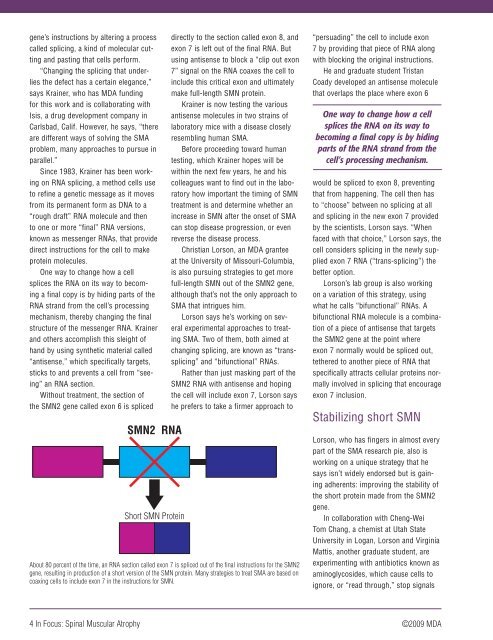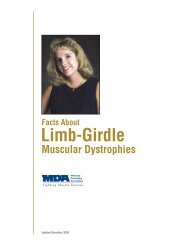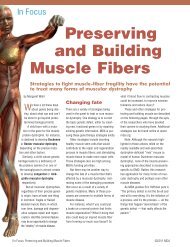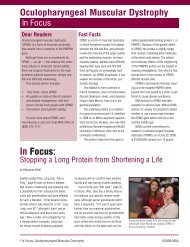Spinal Muscular Atrophy (PDF) - Muscular Dystrophy Association
Spinal Muscular Atrophy (PDF) - Muscular Dystrophy Association
Spinal Muscular Atrophy (PDF) - Muscular Dystrophy Association
You also want an ePaper? Increase the reach of your titles
YUMPU automatically turns print PDFs into web optimized ePapers that Google loves.
gene’s instructions by altering a process<br />
called splicing, a kind of molecular cutting<br />
and pasting that cells perform.<br />
“Changing the splicing that underlies<br />
the defect has a certain elegance,”<br />
says Krainer, who has MDA funding<br />
for this work and is collaborating with<br />
Isis, a drug development company in<br />
Carlsbad, Calif. However, he says, “there<br />
are different ways of solving the SMA<br />
problem, many approaches to pursue in<br />
parallel.”<br />
Since 1983, Krainer has been working<br />
on RNA splicing, a method cells use<br />
to refine a genetic message as it moves<br />
from its permanent form as DNA to a<br />
“rough draft” RNA molecule and then<br />
to one or more “final” RNA versions,<br />
known as messenger RNAs, that provide<br />
direct instructions for the cell to make<br />
protein molecules.<br />
One way to change how a cell<br />
splices the RNA on its way to becoming<br />
a final copy is by hiding parts of the<br />
RNA strand from the cell’s processing<br />
mechanism, thereby changing the final<br />
structure of the messenger RNA. Krainer<br />
and others accomplish this sleight of<br />
hand by using synthetic material called<br />
“antisense,” which specifically targets,<br />
sticks to and prevents a cell from “seeing”<br />
an RNA section.<br />
Without treatment, the section of<br />
the SMN2 gene called exon 6 is spliced<br />
SMN2 RNA<br />
Short SMN Protein<br />
directly to the section called exon 8, and<br />
exon 7 is left out of the final RNA. But<br />
using antisense to block a “clip out exon<br />
7” signal on the RNA coaxes the cell to<br />
include this critical exon and ultimately<br />
make full-length SMN protein.<br />
Krainer is now testing the various<br />
antisense molecules in two strains of<br />
laboratory mice with a disease closely<br />
resembling human SMA.<br />
Before proceeding toward human<br />
testing, which Krainer hopes will be<br />
within the next few years, he and his<br />
colleagues want to find out in the laboratory<br />
how important the timing of SMN<br />
treatment is and determine whether an<br />
increase in SMN after the onset of SMA<br />
can stop disease progression, or even<br />
reverse the disease process.<br />
Christian Lorson, an MDA grantee<br />
at the University of Missouri-Columbia,<br />
is also pursuing strategies to get more<br />
full-length SMN out of the SMN2 gene,<br />
although that’s not the only approach to<br />
SMA that intrigues him.<br />
Lorson says he’s working on several<br />
experimental approaches to treating<br />
SMA. Two of them, both aimed at<br />
changing splicing, are known as “transsplicing”<br />
and “bifunctional” RNAs.<br />
Rather than just masking part of the<br />
SMN2 RNA with antisense and hoping<br />
the cell will include exon 7, Lorson says<br />
he prefers to take a firmer approach to<br />
About 80 percent of the time, an RNA section called exon 7 is spliced out of the final instructions for the SMN2<br />
gene, resulting in production of a short version of the SMN protein. Many strategies to treat SMA are based on<br />
coaxing cells to include exon 7 in the instructions for SMN.<br />
“persuading” the cell to include exon<br />
7 by providing that piece of RNA along<br />
with blocking the original instructions.<br />
He and graduate student Tristan<br />
Coady developed an antisense molecule<br />
that overlaps the place where exon 6<br />
One way to change how a cell<br />
splices the RNA on its way to<br />
becoming a final copy is by hiding<br />
parts of the RNA strand from the<br />
cell’s processing mechanism.<br />
would be spliced to exon 8, preventing<br />
that from happening. The cell then has<br />
to “choose” between no splicing at all<br />
and splicing in the new exon 7 provided<br />
by the scientists, Lorson says. “When<br />
faced with that choice,” Lorson says, the<br />
cell considers splicing in the newly supplied<br />
exon 7 RNA (“trans-splicing”) the<br />
better option.<br />
Lorson’s lab group is also working<br />
on a variation of this strategy, using<br />
what he calls “bifunctional” RNAs. A<br />
bifunctional RNA molecule is a combination<br />
of a piece of antisense that targets<br />
the SMN2 gene at the point where<br />
exon 7 normally would be spliced out,<br />
tethered to another piece of RNA that<br />
specifically attracts cellular proteins normally<br />
involved in splicing that encourage<br />
exon 7 inclusion.<br />
Stabilizing short SMN<br />
Lorson, who has fingers in almost every<br />
part of the SMA research pie, also is<br />
working on a unique strategy that he<br />
says isn’t widely endorsed but is gaining<br />
adherents: improving the stability of<br />
the short protein made from the SMN2<br />
gene.<br />
In collaboration with Cheng-Wei<br />
Tom Chang, a chemist at Utah State<br />
University in Logan, Lorson and Virginia<br />
Mattis, another graduate student, are<br />
experimenting with antibiotics known as<br />
aminoglycosides, which cause cells to<br />
ignore, or “read through,” stop signals<br />
4 In Focus: <strong>Spinal</strong> <strong>Muscular</strong> <strong>Atrophy</strong> ©2009 MDA
















